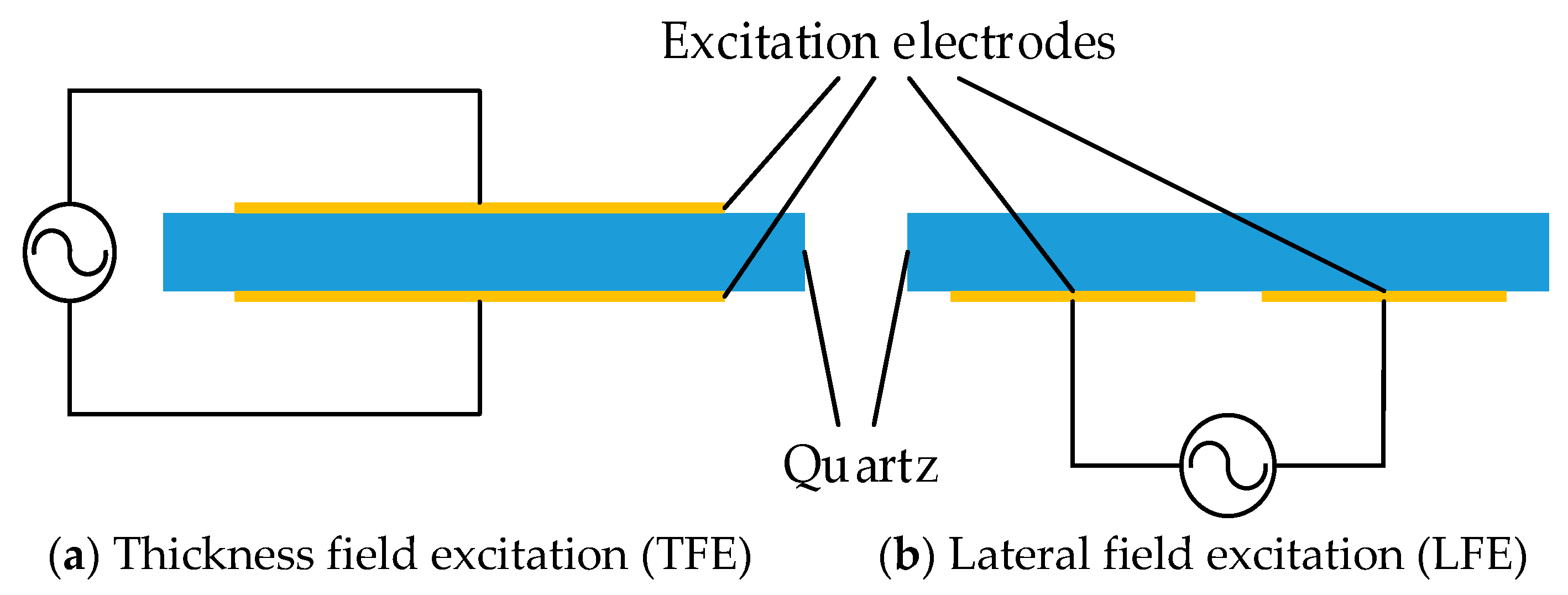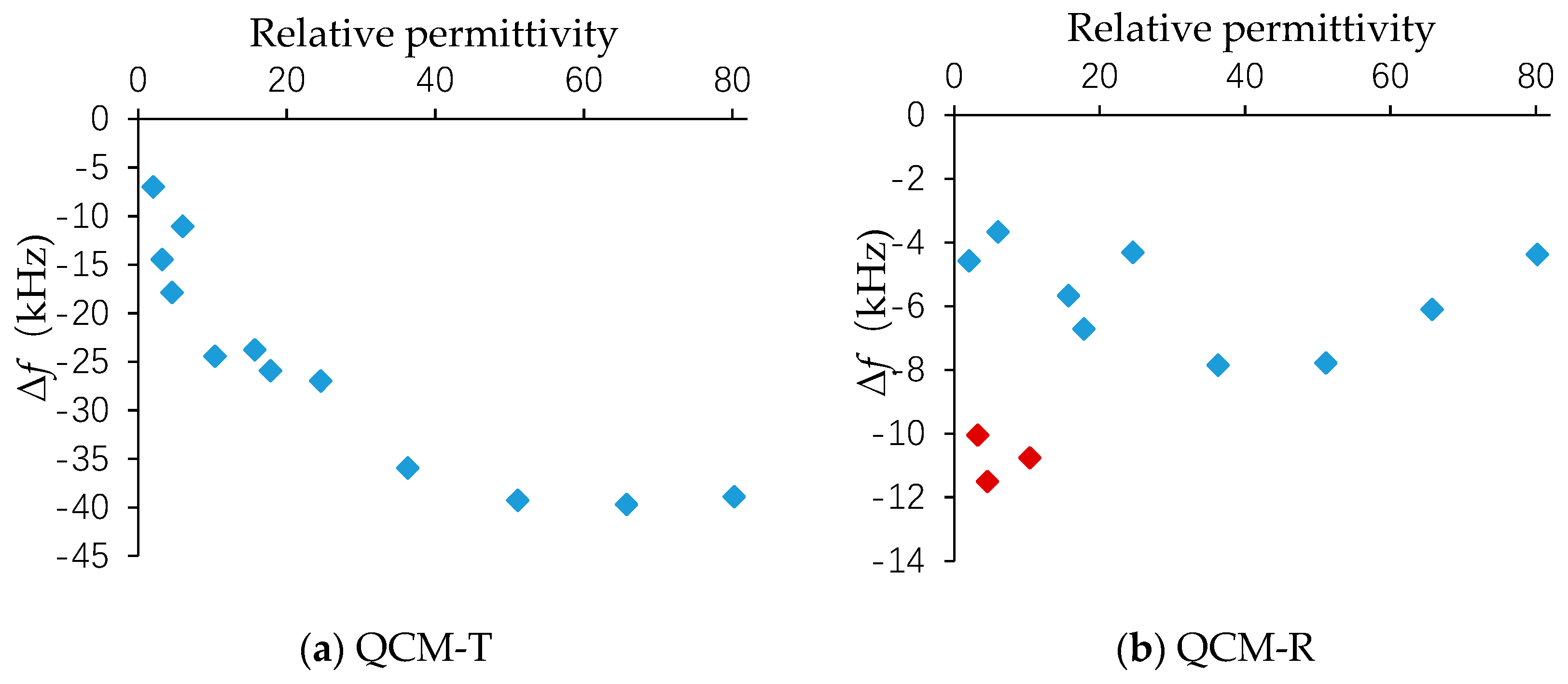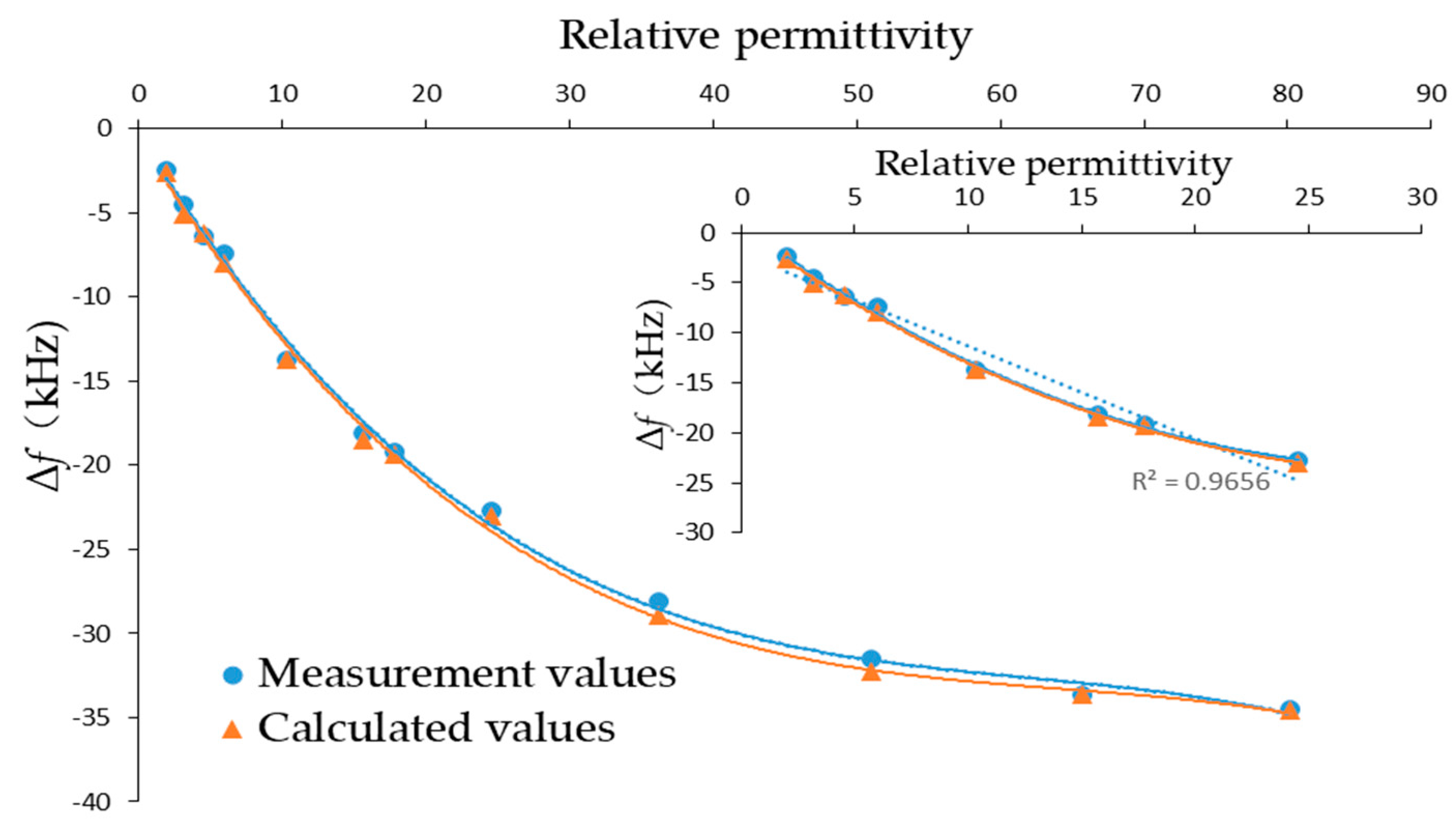Study on Dual Channel Lateral Field Excitation Quartz Crystal Microbalance for Measuring Liquid Electrical Properties
Abstract
:1. Introduction
2. Experimental Materials and Methods
2.1. Design and Fabrication
2.2. Evaluation
3. Results and Discussion
4. Conclusions
Author Contributions
Funding
Conflicts of Interest
References
- Casteleiro-Roca, J.L.; Calvo-Rolle, J.L.; Meizoso-Lopez, M.C.; Piñón-Pazos, A.; Rodríguez-Gómez, B.A. New Approach for the QCM Sensors Characterization. Sens. Actuators A Phys. 2014, 207, 1–9. [Google Scholar] [CrossRef]
- Tan, F.; Ye, P.; Qiu, D.; Guo, L.; Huang, W.; Zeng, H.; Hou, D. A new method for measuring properties of liquid by using a single quartz crystal microbalance. In Proceedings of the Joint Conference of the European Frequency and Time Forum and IEEE International Frequency Control Symposium (EFTF/IFCS), Besancon, France, 9–13 July 2017; pp. 649–651. [Google Scholar]
- Su, J.; Inalpolat, M.; Ge, T.; Esmaeilzadeh, H.; Sun, H. Experimental study and analysis of dropwise condensation using Quartz Crystal Microbalance. In Proceedings of the ASME 2016, Washington, DC, USA, 10–14 July 2016; p. 7. [Google Scholar] [CrossRef]
- Wegener, J.; Steinem, C.; Janshoff, A.; Steinem, C. The quartz crystal microbalance as a novel means to study cell-substrate interactions in situ. ChemInform 2001, 32, 121–151. [Google Scholar] [CrossRef]
- Nomura, T.; Hattori, O. Determination of micromolar concentrations of cyanide in solution with a piezoelectric detector. Anal. Chim. Acta 1980, 115, 323–326. [Google Scholar] [CrossRef]
- Sauerbrey, G. Verwendung von Schwingquarzen zur Wägung dünner Schichten und zur Mikrowägung. Zeitschrift Für Physik 1959, 155, 206–222. [Google Scholar] [CrossRef]
- Kanazawa, K.K.; Gordon, J.G. Frequency of a quartz microbalance in contact with liquid. Anal. Chem. 1985, 57, 1770–1771. [Google Scholar] [CrossRef]
- Shen, F.; Lee, K.H.; O’Shea, S.J.; Lu, P.; Ng, T.Y. Frequency Interference between Two Quartz Crystal Microbalances. IEEE Sens. 2003, 3, 274–281. [Google Scholar] [CrossRef]
- Hempel, U.; Lucklum, R.; Vetelino, J.F.; Hauptmann, P. Advanced application of the impedance spectrum of a lateral field excited sensor. Sens. Actuators A Phys. 2008, 142, 97–103. [Google Scholar] [CrossRef]
- Wang, W.; Zhang, C.; Zhang, Z.; Liu, Y.; Feng, G. Three operation modes of lateral-field-excited piezoelectric devices. Appl. Phys. Lett. 2008, 93, 242906. [Google Scholar] [CrossRef]
- Ma, T.F.; Wu, R.X.; Wang, J.; Du, J.-K.; Yuan, L.-L.; Yu, F.-P.; Xie, C. Coupled extension and thickness-twist vibrations of lateral field excited AT-cut quartz plates. Acta Mech. Sin. 2014, 30, 67–72. [Google Scholar] [CrossRef]
- Liu, B.; Jiang, Q.; Hu, Y.; Yang, J. High-frequency vibrations of piezoelectric plates driven by lateral electric fields. Int. J. Eng. Sci. 2011, 49, 1435–1442. [Google Scholar] [CrossRef]
- Li, Y.; Liu, Y.; Liu, J.; Tang, H. Modification of a lateral field excitation sensor based on a two-step coating technique and its application as a gas sensor. Meas. Sci. Technol. 2014, 25, 065106. [Google Scholar] [CrossRef]
- Mccann, D.F.; French, L.A.; Wark, M.S.; Vetelino, J.F. Recent advances in lateral field excited and monolithic spiral coil acoustic transduction bulk acoustic wave sensor platforms. Meas. Sci. Technol. 2009, 20, 124001. [Google Scholar] [CrossRef]
- Mccann, D.F.; Parks, J.M.; Mcgann, J.M.; da Cunha, M.P.; Vetelino, J.F. 4D-5 Lateral Field Excited High Frequency Bulk Acoustic Wave Sensors. In Proceedings of the IEEE Ultrasonics Symposium Proceedings, New York, NY, USA, 28–31 October 2007; pp. 264–267. [Google Scholar]
- Hempel, U.; Lucklum, R.; Hauptmann, P. Application of a Lateral Field Excited Acoustic Wave Device as a New Sensor Principle in Biointerface Analysis. In Proceedings of the Transducers International Solid-State Sensors, Actuators & Microsystems Conference, Lyon, France, 10–14 June 2007; pp. 1729–1732. [Google Scholar]
- French, L.A.; Fitzgerald, M.; Vetelino, J.F. An equivalent circuit model for a liquid loaded lateral-field excited acoustic wave sensor. In Proceedings of the IEEE International Ultrasonics Symposium, Orlando, FL, USA, 18–21 October 2011; pp. 1194–1199. [Google Scholar]
- Hempel, U.; Schneider, T.; Doerner, S.; Lucklum, R.; Hauptmann, P.R.; Vetelino, J.F. 5D-2 Application of a Portable RF Impedance Spectrum Analyzer for the Investigation of Lateral Field Excited Acoustic Wave Sensors in a Liquid Environment. In Proceedings of the Ultrasonics Symposium, New York, NY, USA, 28–31 October 2007; pp. 373–376. [Google Scholar]
- Hu, Y.; French, L.A.; Radecsky, K.; da Cunha, M.P.; Millard, P.; Vetelino, J.F. A lateral field excited liquid acoustic wave sensor. IEEE Trans. Ultrason. Ferroelectr. Freq. Control 2004, 51, 1373–1380. [Google Scholar] [CrossRef]
- Abe, T.; Kato, H. Design and Evaluation of an Antiparallel Coupled Resonator for Chemical Sensor Applications. Anal. Chem. 2007, 79, 6804–6806. [Google Scholar] [CrossRef] [PubMed]
- Rocklein, M.N.; George, S.M. Temperature-Induced Apparent Mass Changes Observed during Quartz Crystal Microbalance Measurements of Atomic Layer Deposition. Anal. Chem. 2003, 75, 4975–4982. [Google Scholar] [CrossRef]
- Liang, J.; Zhang, J.; Zhou, W.; Ueda, T. Development of a Flow Injection Based High Frequency Dual Channel Quartz Crystal Microbalance. Sensors 2017, 17, 1136. [Google Scholar] [CrossRef] [PubMed]
- Winters, S.; Bernhardt, G.; Vetelino, J. A dual lateral-field-excited bulk acoustic wave sensor array. IEEE Trans. Ultrason. Ferroelectr. Freq. Control 2013, 60, 573–578. [Google Scholar] [CrossRef]
- Abe, T.; Higuchi, M. A Monolithic QCM Array Designed for Mounting on a Flow Cell. IEEE Sens. J. 2011, 11, 86–90. [Google Scholar] [CrossRef]
- Winters, S.; Bernhardt, G.; Frankel, D.J.; Vetelino, J. Lateral field excitation of well structures in quartz. In Proceedings of the IEEE Ultrasonics Symposium, Beijing, China, 2–5 November 2008; pp. 272–275. [Google Scholar]
- Hempel, U.; Lucklum, R.; Hauptmann, P.R.; EerNisse, E.P.; Puccio, D.; Fernandez Diaz, R. Quartz crystal resonator sensors under lateral field excitation—A theoretical and experimental analysis. Meas. Sci. Technol. 2008, 19, 055201. [Google Scholar] [CrossRef]
- Pinkham, W.; Wark, M.; Winters, S.; French, L.; Frankel, D.J.; Vetelino, J.F. A lateral field excited acoustic wave pesticide sensor. Proc. IEEE Ultrason. Symp. 2007, 4, 1287–1290. [Google Scholar]
- Meissner, M.; French, L.A.; Pinkham, W.; York, C.; Bernhardt, G.; da Cunha, M.P.P.; Vetelillo, J.F. Electrode optimization for a lateral field excited acoustic wave sensor. In Proceedings of the IEEE Ultrasonics Symposium, Montreal, QC, Canada, 23–27 August 2004. [Google Scholar]
- Michalzik, M.; Wilke, R. Miniaturized QCM-based flow system for immunosensor application in liquid. Sens. Actuators 2005, B111, 410–415. [Google Scholar] [CrossRef]
- Michalzik, M.; Wendler, J.; Rabe, J.; Büttgenbach, S.; Bilitewski, U. Development and application of a miniaturized quartz crystal microbalance as immunosensor for bone morphogenetic protein-2. Sens. Actuators B Chem. 2005, B105, 508–515. [Google Scholar] [CrossRef]
- Sagmeister, B.P.; Graz, I.M.; Schwödiauer, R.; Gruber, H.; Bauer, S. User-friendly, miniature biosensor flow cell for fragile high fundermental frequency quartz crystal resonators. Biosens. Bioelectron. 2009, 24, 2643–2648. [Google Scholar] [CrossRef] [PubMed]
- Liang, J.; Zhang, J.; Wang, P.; Liu, C.; Qiu, S.; Ueda, T. Development of Portable Quartz Crystal Microbalance for Biosensor Applications. Sens. Mater. 2016, 28, 201–207. [Google Scholar]
- Liu, B.; Jiang, Q.; Xie, H.; Yang, J. Energy trapping in high-frequency vibrations of piezoelectric plates with partial mass layers under lateral electric field excitation. Ultrasonics 2011, 51, 376–381. [Google Scholar] [CrossRef] [PubMed]
- Wang, W.; Zhang, C.; Zhang, Z.; Ma, T.; Feng, G. Energy-trapping mode in lateral-field-excited acoustic wave devices. Appl. Phys. Lett. 2009, 94, 192901. [Google Scholar] [CrossRef]
- Losada-Pérez, P.; Polat, O.; Parikh, A.N.; Seker, E.; Renner, F.U. Engineering the interface between lipid membranes and nanoporous gold: A study by quartz crystal microbalance with dissipation monitoring. Biointerphases 2018, 13, 011002. [Google Scholar] [CrossRef] [PubMed]
- Wang, W.; Zhang, Z.; Zhang, C.; Liu, Y.; Feng, G.; Jing, G. Pseudo-LFE study in AT-cut quartz for sensing applications. In Proceedings of the 2008 IEEE Sensors, Lecce, Italy, 26–29 October 2008; pp. 1548–1551. [Google Scholar]









| Parameter | In Air | In Deionized Water | ||
|---|---|---|---|---|
| QCM-T | QCM-R | QCM-T | QCM-R | |
| Resonant Frequency (MHz) | 16.494797 | 16.202182 | 16.456062 | 16.196325 |
| Q Value | 30671 | 41743 | 1267 | 1127 |
| Conductance (mS) | 0.033 | 10.92 | 0.178 | 0.295 |
| Solutions | Viscosity (cP) | Density (g/cm3) | Relative Permittivity |
|---|---|---|---|
| Dodecane | 1.383 | 0.753 | 2.012 |
| Methyl oleate | 5.5 | 0.8704 | 3.21 |
| Dibutyl sebacate | 7.96 | 0.933 | 4.54 |
| n-Propyl acetate | 0.59 | 0.888 | 6 |
| 1-octanol | 7.69 | 0.82143 | 10.34 |
| Ethyl Acetoacetate | 1.5081 | 1.02126 | 15.7 |
| Butyl Alcohol | 2.95 | 0.806 | 17.8 |
| Ethanol | 1.103 | 0.78506 | 24.55 |
| 60% Isopropanol | 3.033 | 0.8786 | 36.28 |
| 40% Isopropanol | 2.917 | 0.9256 | 51.07 |
| 20% Isopropanol | 2.059 | 0.9666 | 65.72 |
| Pure water | 1.002 | 0.99707 | 80.2 |
© 2019 by the authors. Licensee MDPI, Basel, Switzerland. This article is an open access article distributed under the terms and conditions of the Creative Commons Attribution (CC BY) license (http://creativecommons.org/licenses/by/4.0/).
Share and Cite
Liang, J.; Kong, D.; Liu, C. Study on Dual Channel Lateral Field Excitation Quartz Crystal Microbalance for Measuring Liquid Electrical Properties. Sensors 2019, 19, 1253. https://doi.org/10.3390/s19051253
Liang J, Kong D, Liu C. Study on Dual Channel Lateral Field Excitation Quartz Crystal Microbalance for Measuring Liquid Electrical Properties. Sensors. 2019; 19(5):1253. https://doi.org/10.3390/s19051253
Chicago/Turabian StyleLiang, Jinxing, Debo Kong, and Chaolin Liu. 2019. "Study on Dual Channel Lateral Field Excitation Quartz Crystal Microbalance for Measuring Liquid Electrical Properties" Sensors 19, no. 5: 1253. https://doi.org/10.3390/s19051253
APA StyleLiang, J., Kong, D., & Liu, C. (2019). Study on Dual Channel Lateral Field Excitation Quartz Crystal Microbalance for Measuring Liquid Electrical Properties. Sensors, 19(5), 1253. https://doi.org/10.3390/s19051253




